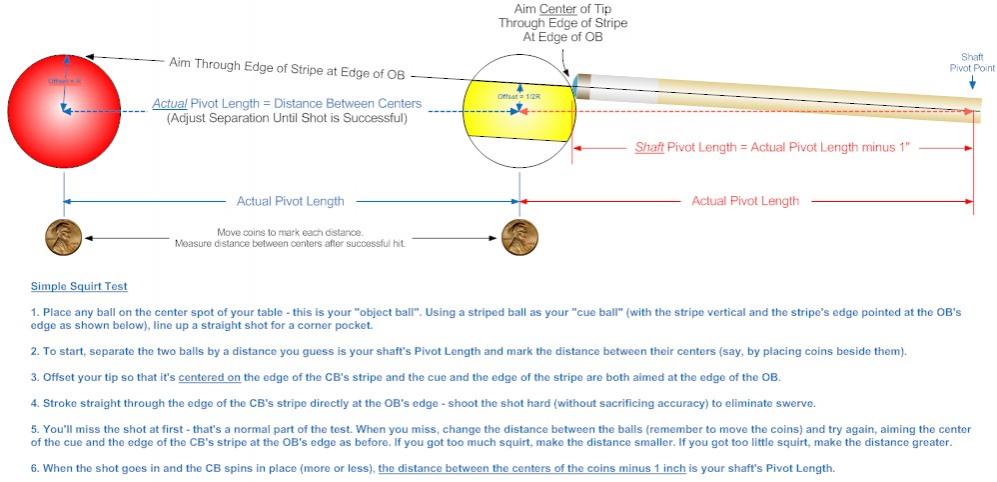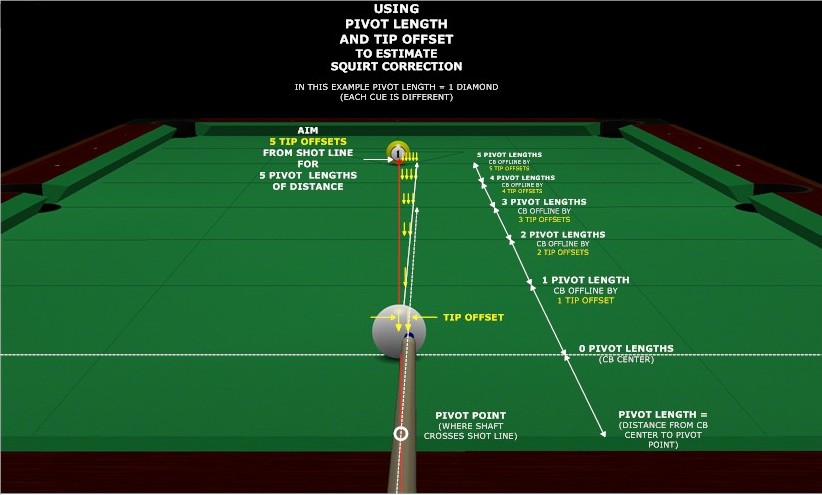How do I determine the natural pivot length for my shaft, and why should I?
The natural pivot length of a cue is the bridge position where a cue pivot (from Back-Hand English/BHE or unintentional stroke swoop or stroking errors) exactly cancels CB deflection (squirt) with a perfectly level cue or for a very fast and short shot (where swerve is negligible). The natural pivot length can be measured and used to compare the CB deflection characteristics of different cues and shafts. The following video, at the 4:22 point, demonstrates a recommended procedure for doing this:
Effective pivots lengths (compensating for the combined effects of squirt and swerve) for a wide range of shafts (for a given shot speed and distance) can be found in the shaft comparison table. These numbers are useful for comparison purposes.
To get the most accuracy with natural pivot length measurements, one should use fast speed over a short distance with the cue as level as possible (ideally perfectly level, for example with a machine that doesn’t need to reach over a rail). Otherwise, the results of the test will vary too much with shot speed, shot distance, cue elevation, and cloth conditions. Then people would not be able to directly compare measured values. For more info, see Rules of CB Deflection (Squirt) Testing. The goal of the test is to measure just the cue’s characteristics, not how the cue produces different results at a table for different shots by different people under different conditions.
Another procedure for measuring natural pivot length is demonstrated in this clip from Vol. II of The Video Encyclopedia of Pool Shots:
“Squirt – Part IV: BHE, FHE, and pivot-length calibration” (BD, November, 2007) also presents a simple procedure for measuring the natural pivot length for a cue; although, throw is more of a factor in these measurements. The procedure in the article yields more of an “effective pivot length,” which compensates for both squirt and throw. This pivot length will be longer than the actual natural pivot length.
Should I use a shaft with a natural pivot length matched to my preferred bridge length?
For short and/or fast-speed shots, with a bridge length well matched to the natural pivot length of a shaft, the effects of any stroke swoop (intentional or unintentional) can be canceled by the resulting cue ball deflection, resulting in a straight shot. This can be particularly useful with a break cue, where stroking errors are more likely at the fast speeds used. For more info, see Diagram 4 in “Squirt – Part IV: BHE, FHE, and pivot-length calibration” (BD, November, 2007) and break shot technique and equipment advice.
However, for all other shots, CB deflection (the net effect of squirt and swerve) varies a lot with shot speed, shot distance, and the type and amount of spin. For more information, see aim compensation when using sidespin.
Most players, especially intermediate level and above, don’t have much issue with stroke straightness, so automatic stroke-pivot-error correction isn’t really important (unless one unadvisedly uses an intentional swoop stroke, or with a power break shot where control can be an issue). Also, there are advantages to using an LD shaft, which can have a natural pivot length much longer than most people’s preferred bridge lengths. Regardless, one can learn to adjust for CB deflection over a wide range of shots with any shaft and any bridge length. For more info, see the System for Aiming With Sidespin (SAWS).
If you don’t have a very straight stroke or if you have a bad habit of swooping your stroke, it can definitely help to have a shaft with an effective pivot length for medium-speed and medium-distance shots well matched to your preferred bridge length, where BHE pivot will cancel the net effects of squirt and swerve for average shot speeds and distances. However, it is much better to work on straightening your stroke and learning how to compensate your aim for squirt, swerve, and throw over a wide range of shot types. If you don’t, you won’t be able to reach a high level of play.
If you hit most shots close to the same speed and over close to the same distance, where BHE or stroke swoop error would exactly cancel the effects of squirt and swerve, then it would be best to have a shaft with an effective pivot length (for the given shot speed and distance) be well matched to your bridge length.
from Patrick Johnson:
The traditional “aim-and-pivot” squirt test keeps the balls at the same distance and pivots the shaft to different angles by shifting the bridge hand (pivot point) back and forth until the shot is made.
This Simple Squirt Test keeps the shaft aimed at the same two points on the CB and OB while changing the distance between the balls until the shot is made. Changing the distance between the balls while aiming at the same points on them changes the angle of the cue in (hopefully) a more controlled way that can be more accurately measured.

Why do you use such fast speed when testing for natural pivot length? Why not use speeds more typical during actual play?
If your only goal is to see how two shafts compare for you for a given stroke speed, shot distance, cloth condition, and cue elevation, you can use whatever speed you want. But you will not be able to directly compare your experience with anybody else’s experience; and if you don’t hit the CB at the exact same speed with the exact same cue elevation with each shaft, your comparison might be flawed.
To measure a shaft’s “natural pivot length,” you must measure squirt only, and not the combined effects of squirt and swerve (AKA squerve). One way to do this (e.g., in a cue testing machine, or on a table with a rail removed) is to position the cue perfectly level so there will be no swerve. With a perfectly level cue, the pivot length measurement would be the same regardless of shot speed. A perfectly level cue is not possible at a pool table since the cue must be elevated slightly to clear over the rails. With cue elevation, swerve is unavoidable. However, if you use fast speed over a short distance, swerve will be negligible. If you don’t use a perfectly level cue or a short distance shot at fast speed, you will not be measuring the “natural pivot length” of the shaft. Instead, you will be measuring the “effective pivot length” for a given shot distance, shot speed, cue elevation, and cloth conditions. This would make it nearly impossible to accurately compare one shaft to another especially with different people doing tests with different strokes on different tables. If you instead measure the “natural pivot length,” this will be the exact number for that shaft that anybody could measure on any table. And to know how two shafts might compare (without having to physically test them yourself), all you need to know is the “natural pivot length” for each shaft.
For more information, see the Rules of CB Deflection (Squirt) Testing.
Is there a pivot point for a cue that will compensate for throw and/or swerve in addition to squirt?
Unfortunately, the amount of throw varies with cut angle, shot speed, type of sidespin, amount of topspin or bottom-spin, and ball conditions. Also, swerve depends on shot speed, shot distance, cue elevation, amount and type of sidespin/roll, and ball/cloth conditions. Therefore, it is difficult to predict a required cue pivot point to compensate for anything more than squirt. Maybe this could be done for medium speed shots, at medium distances, with a medium amount of sidespin (with a consistent amount of draw or follow); but otherwise, aim-and-pivot aim compensation alone is not adequate to account for all of the subtleties associated with squirt, swerve, and throw. Having said all of that, aim-and-pivot methods (e.g., BHE and/or FHE) can still be very helpful to many players on many shots, especially if using the System for Aiming With Sidespin (SAWS).
How much CB deflection does a cue of given natural pivot length produce?
TP B.1 uses physics and math to predict the natural pivot length for a cue from squirt angle measurements. Here are some of the conclusions supported by the analysis:
– Squirt angle varies nearly linearly with tip offset, and tip offset varies nearly linearly with cue pivot angle. This is what makes the BHE and FHE methods effective, provided swerve and throw are also taken into consideration (see aim compensation using sidespin).
– A cue’s natural pivot length does vary a little with both tip offset and tip shape (radius), so when comparing different cues with experimental measurements, it is important to use the same tip shape and the same amount of tip offset (english) for each cue.
– Cue pivot lengths reported by Platinum Billiards report a range from 8 inches (for a “high-squirt” cue) to 14 inches (for a “low-squirt” cue). Numbers from Colin’s procedure (see above) seem to back up this range.
– Expected cue pivot lengths reported in Ron Shepard’s 2001 paper “Everything you Always Wanted to Know About Cue Ball Squirt, but Were Afraid to Ask” appear to be much too large. He reports a range from 10 inches (for a “high-squirt” cue) to 50 inches (for a “low-squirt” cue).
For more information about squirt (AKA “cue ball deflection”) and how it is related to the natural pivot length of a cue, see the squirt (cue ball deflection) resource page.
from Patrick Johnson:
Knowing your cue’s Pivot Length is the basis for a simple method of visualizing squirt correction that can reduce the guesswork.
Pivot Length is the distance from your cue’s tip to its Pivot Point, the place to pivot your cue to apply squirt-correcting backhand english. This is because (here’s the useful part ->) Pivot Length is the distance the CB travels to be off target by exactly the same distance as your Tip Offset from the CB’s center.
That means you should aim your shot one Tip Offset to the side of your target for each Pivot Length between the CB and the OB (minus something for swerve).
Here’s a drawing with some detail about how to do that. For illustration it assumes a Pivot Length of exactly 12.5 inches (1 diamond on a 9-foot table), which is probably not an uncommon “high squirt” Pivot Length. Of course, each cue’s Pivot Length can be different.

Dr. Dave keeps this site commercial free, with no ads. If you appreciate the free resources, please consider making a one-time or monthly donation to show your support:
